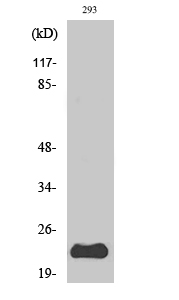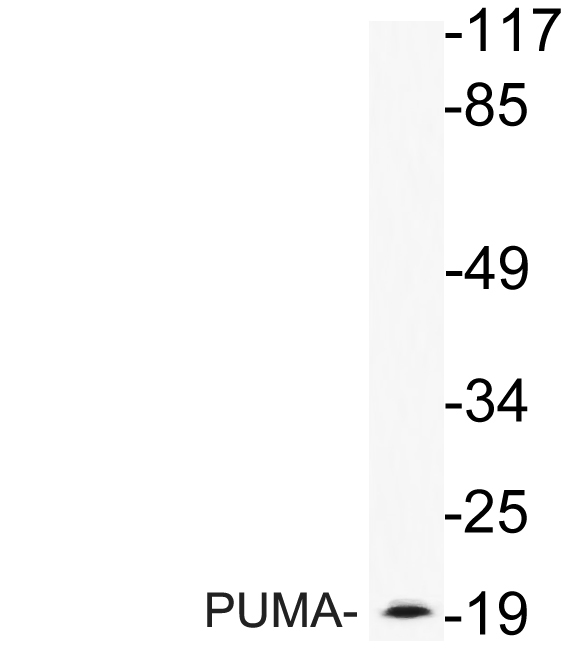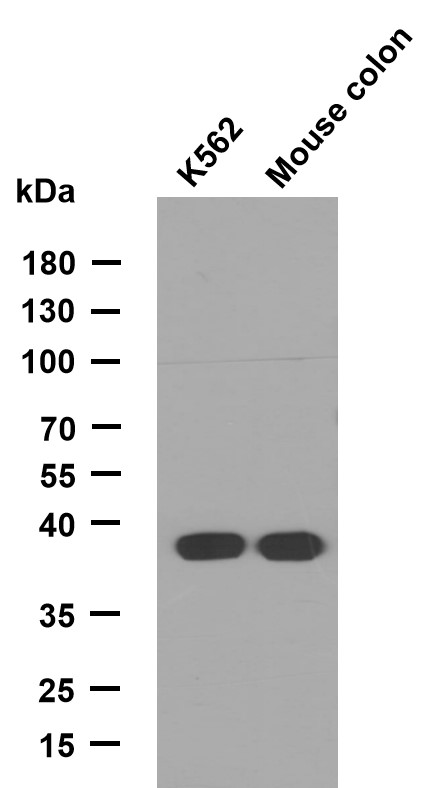PUMA Polyclonal Antibody
- Catalog No.:YT3907
- Applications:WB IF;ELISA
- Reactivity:Human;Mouse;Rat
- Target:
- PUMA
- Fields:
- >>Platinum drug resistance;>>p53 signaling pathway;>>Apoptosis;>>Apoptosis - multiple species;>>Hippo signaling pathway;>>Huntington disease;>>Measles;>>Pathways in cancer;>>Colorectal cancer
- Gene Name:
- BBC3
- Protein Name:
- Bcl-2-binding component 3
- Human Gene Id:
- 27113
- Human Swiss Prot No:
- Q9BXH1
- Mouse Gene Id:
- 170770
- Mouse Swiss Prot No:
- Q99ML1
- Rat Gene Id:
- 317673
- Rat Swiss Prot No:
- Q80ZG6
- Immunogen:
- The antiserum was produced against synthesized peptide derived from human PUMA. AA range:120-169
- Specificity:
- PUMA Polyclonal Antibody detects endogenous levels of PUMA protein.
- Formulation:
- Liquid in PBS containing 50% glycerol, 0.5% BSA and 0.02% sodium azide.
- Source:
- Polyclonal, Rabbit,IgG
- Dilution:
- WB 1:500-2000 IF 1:100-300 ELISA 1:5000-20000 Not yet tested in other applications.
- Purification:
- The antibody was affinity-purified from rabbit antiserum by affinity-chromatography using epitope-specific immunogen.
- Concentration:
- 1 mg/ml
- Storage Stability:
- -15°C to -25°C/1 year(Do not lower than -25°C)
- Other Name:
- BBC3;PUMA;Bcl-2-binding component 3;JFY-1;p53 up-regulated modulator of apoptosis
- Observed Band(KD):
- 23kD
- Background:
- This gene encodes a member of the BCL-2 family of proteins. This family member belongs to the BH3-only pro-apoptotic subclass. The protein cooperates with direct activator proteins to induce mitochondrial outer membrane permeabilization and apoptosis. It can bind to anti-apoptotic Bcl-2 family members to induce mitochondrial dysfunction and caspase activation. Because of its pro-apoptotic role, this gene is a potential drug target for cancer therapy and for tissue injury. Alternative splicing results in multiple transcript variants. [provided by RefSeq, Dec 2011],
- Function:
- function:Essential mediator of p53-dependent and p53-independent apoptosis.,induction:By DNA damage, glucocorticoid treatment, growth factor deprivation and p53.,similarity:Belongs to the Bcl-2 family.,subcellular location:Localized to the mitochondria in order to induce cytochrome c release.,subunit:Interacts with MCL1 and BCL2A1 (By similarity). Interacts with BCL2 and BCL2L1/BCL-XL.,tissue specificity:Ubiquitously expressed.,
- Subcellular Location:
- Mitochondrion . Localized to the mitochondria in order to induce cytochrome c release.
- Expression:
- Ubiquitously expressed.
- June 19-2018
- WESTERN IMMUNOBLOTTING PROTOCOL
- June 19-2018
- IMMUNOHISTOCHEMISTRY-PARAFFIN PROTOCOL
- June 19-2018
- IMMUNOFLUORESCENCE PROTOCOL
- September 08-2020
- FLOW-CYTOMEYRT-PROTOCOL
- May 20-2022
- Cell-Based ELISA│解您多样本WB检测之困扰
- July 13-2018
- CELL-BASED-ELISA-PROTOCOL-FOR-ACETYL-PROTEIN
- July 13-2018
- CELL-BASED-ELISA-PROTOCOL-FOR-PHOSPHO-PROTEIN
- July 13-2018
- Antibody-FAQs
- Products Images

- Immunofluorescence analysis of A549. 1,primary Antibody was diluted at 1:200(4°C overnight). 2, Goat Anti Rabbit IgG (H&L) - Alexa Fluor 488 Secondary antibody was diluted at 1:1000(room temperature, 50min).3, Picture B: DAPI(blue) 10min.

- Western Blot analysis of various cells using PUMA Polyclonal Antibody

- Western blot analysis of lysate from 293 cells treated with EGF, using PUMA antibody.



